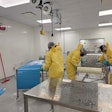JustFoodForDogs, the inventor of the fresh whole food category for pets, is leading the charge in pet nutrition and wellness and backing its efforts with robust scientific research. Having dedicated more than $1 million to help fund nutritional research, the work will advance the industry with learnings that will translate into better health for pets across the globe.
The most recent study, conducted by the University of Illinois Department of Animal Sciences under Kelly Swanson, Ph.D., professor of animal and nutritional sciences, is published in the peer-reviewed Journal of Animal Science. The data shows that dogs who ate JustFoodforDogs fresh food absorbed more nutrients and consumed a larger volume of food (as-fed) than when on a diet of processed kibble. Additionally, the dogs fed a fresh whole food diet produced up to 66% less poop than when eating kibble.
The study compared the digestibility of premium dry pet food (Blue Buffalo Chicken and Brown Rice Recipe), fresh feed-grade processed pet food (Freshpet Roasted Meals Tender Chicken Recipe), and human-grade fresh whole food (JustFoodForDogs Chicken & White Rice Recipe and Beef & Russet Potato Recipe). The researchers found that dogs eating human-grade fresh whole food produced 2.0 to 2.9 times (up to 66%) less feces than dogs eating dry pet food. When compared to the fresh processed brand, feeding the real whole food resulted in 1.5 to 1.7 times (up to 41%) less feces.
This latest research demonstrates that by feeding pets fresh ingredients, less waste goes in and less waste goes out. Feeding kibble, a highly processed pellet often made from the leftover waste and unusable ingredients from the human food chain, has the opposite effect.
“Based on past research we’ve conducted, I’m not surprised with the results when feeding human-grade compared to an extruded dry diet,” says Dr. Swanson, the Kraft Heinz Company Endowed Professor in Human Nutrition and co-author on the Journal of Animal Science study. “However, I did not expect to see how well the human-grade fresh food performed, even compared to a fresh commercial processed brand.”
The study was a follow-up to a 2019 research study conducted by Dr. Swanson and the University of Illinois and published in Translational Animal Science, a peer-reviewed journal, that showed JustFoodForDogs food tested up to 40% more digestible than comparable testing done on kibble.
Previous research efforts also point to the benefits of a fresh food diet for pets.
Also in 2019, researchers at Western University of Health Science College of Veterinary Medicine and the University of California, Davis, conducted what they believe to be the first scientific research comparing both grain-containing and grain-free pet food with respect to mycotoxins. The study, published in the Journal of Toxicology Communications, found that 75% of dry pet food, or kibble, may contain levels of toxins linked to immunosuppression and chronic disease.
The company also embarked on the pet food industry’s only feeding trials utilizing fresh whole food diets, which showed that not only were the JustFoodForDogs recipes beneficial for long-term feeding, but they also promoted healthy functioning of the immune system in dogs. The data led to a research poster and abstract published in the Journal of Animal Physiology and Animal Nutrition in 2014.
“This continued research is more scientific evidence of what we have known for years - a fresh whole food diet is better for our pets than processed kibble,” said Dr. Oscar Chavez, professor of veterinary clinical nutrition and chief medical officer at JustFoodForDogs. “We know this to be true from research for humans and the same parallels exist for dogs.”
JustFoodForDogs began cooking fresh food for pets in Open Kitchens in 2010 after founder Shawn Buckley learned what was legally allowed to be in pet food. The company’s commitment to pet health and ongoing nutrition research spans more than a decade.











